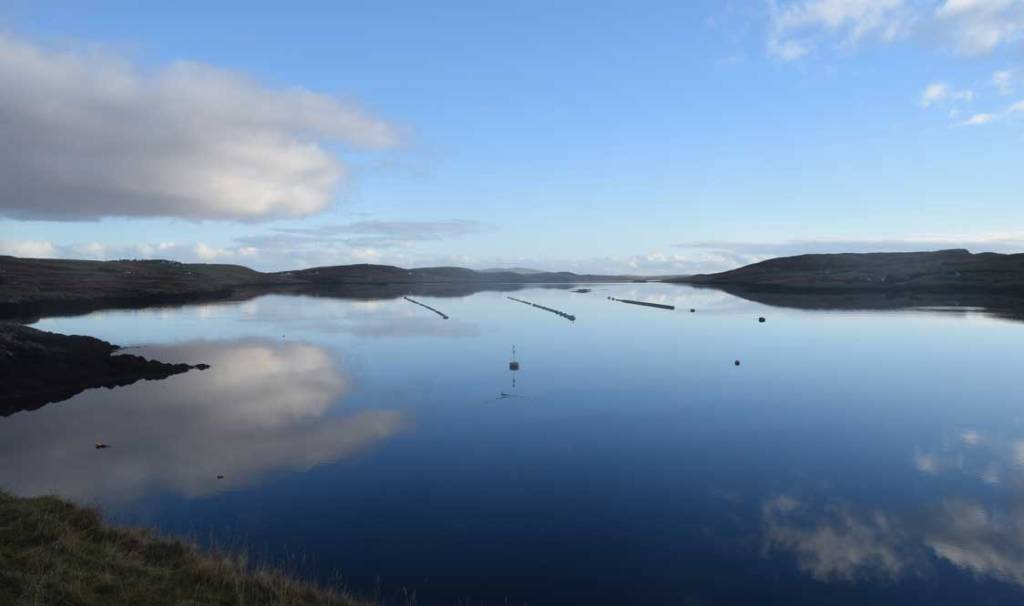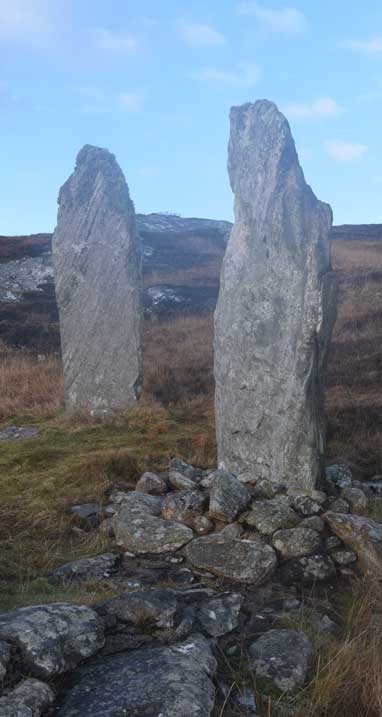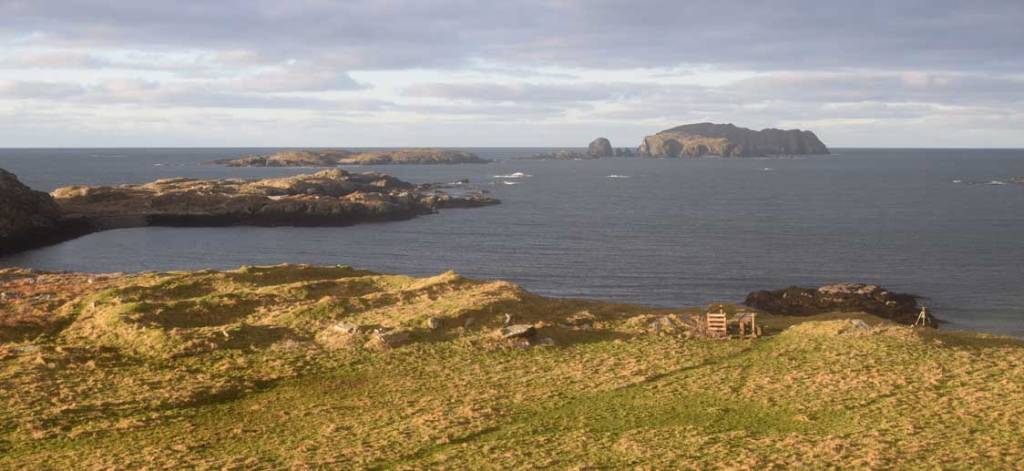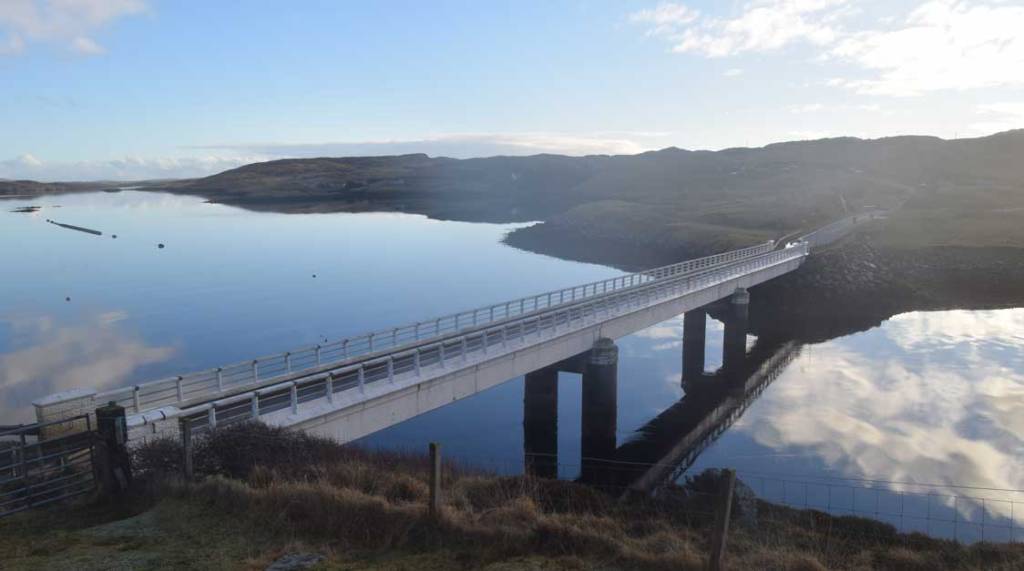
First and foremost, a very Happy New Year to you. I hope you had a good one, despite the rather severe restrictions that curtailed the celebrations. If everyone pulls together I’m sure we’ll be able to plan a party worthy of two new years together next time around.
Here in the Hebrides the first few days of January have been very kind weather wise. The skies have mostly been clear, albeit the temperature has fallen below freezing at night. The days have been frosty but sunny. We’ve had to tip the ice-frisbees from the garden bird baths and chuck a little extra seed around for the impatient little blighters who line the fence like so many tiny Oliver Twists

New Year’s Day saw us do a local walk to Shawbost beach and round a favourite circuit back home, but we set our sights on a slightly bigger adventure for January 2nd. The Island of Great Bernara lies just off the west coast of Lewis, connected by a road bridge since 1953.
Despite our numerous travels across the Outer Hebrides we had set foot on Great Bernara, so Redhead and I decided to add it to our list of Scottish islands. With it being January very little would be open in the way of visitor attractions, and of course Covid ensured that was doubly true, so this was very much a provisional getting to know you visit and I’ll report more when permitted.

East and West Loch Roag encircle the island, both technically part of the Atlantic Ocean, but a relatively small part of course! Where the two meet there is a pre-stressed concrete bridge which provides road access from Lewis.

The construction is unusual but the 108ft bridge was much needed and the design required far less steel than most bridges (a component in very short supply just after the war) so it suited the circumstances. Construction was hazardous because of the strong currents and the divers who excavated the holes for the bridge piers had to be tied to scaffolding structures to avoid being swept away.
Before the bridge was built the movement of people, livestock, produce and vehicles to and from the island had involved precarious boat exploits battling the currents and all too often being cancelled altogether if the weather further complicated the navigation.
It’s reasonable to assume that if the bridge had not been built Great Bernara may by now have been uninhabited, the challenges of keeping pace with modern life being near impossible without a reliable link to the main island. Because of the bridge Stornoway is accessible for shopping, medical care and secondary education and the mobile bank and library can visit the island, as can various other deliveries and transport, including livestock movement.

On the hillside immediately after you cross the bridge the Cleitir standing stones look back across the water. There are four stones, three still upright and one fallen. They form a semi-circle, but the other half would have protruded out beyond the 40ft cliff that drops into the narrow strait below. There is no evidence that the cliff has collapsed within the relevant human timescales, so it must be assumed the semi-circle was deliberately built as such, making it unique within the British Isles.

When the winter sun is low a strange phenomenon can occur as a person standing between the tallest stone and the cliff edge will produce a double shadow on the stone behind them. It is caused by the sun shining directly but also reflecting off the water below. I regret that conditions on the day we were there did not deliver the goods so I cannot provide the photographic evidence you probably crave. I’ll keep this in mind for future visits and see what I can do.
The Cleitir stones are also listed as ‘Callanish 8’. The Callanish stones are actually spread across at least nineteen sites with some still being researched, although the main stones at ‘Callanish 1’ are by far the most famous. I hope to post a fuller piece about Callanish when I’ve had further opportunity to visit the sites and read up on the details.
The main township on Great Bernara is Breaclete where there is a museum with further information about the island (seasonal opening) and, more practically, a small shop and petrol station.
The 1874 riot on the island resulted from attempts to evict more than 50 householders. The sheriff-officer, Donal Munro, who was also the factor, tried to serve the writs but was met with violent opposition. Munro may have seriously misjudged his actions. A small number of the resisting crofters were arrested but were found not guilty at trial. However, Munro had attacked one of the crofters who was in handcuffs and was found guilty of assault. He lost his several public offices as a result. There is a memorial to the events just north of Breaclete.

The jewel amongst Great Bernara’s offerings must be Bostadh beach at the northern tip of the island. The beach itself is glorious and there is good walking in and around the area – as always ‘walkhighlands’ is a good reference point.
The fact that such a remote spot warrants decent car parking including bus areas, public toilets (open even in January 2021 – Covid guidelines to the fore!) and various information boards etc. speaks volumes about how popular the beach can be in a normal spring and summer.

An interesting focal point on the beach is the installation of a Time and Tide Bell. This project installs their community art bells at various points around the UK coast (can I lodge a gentle protest that only one is in Scotland so far, albeit I have the good fortune to find it not far from my new home!). The project’s purpose is not to promote the artist but to gift to the community an interesting piece of public art, at the same time drawing attention to the rising seas and the changing climate. As the tide flows in the bell is rung by the movement of the waves.

The bell design and casting is very clever in that the one bell can produce a number of notes depending on how the water strikes the clanger. As average tidal levels rise the bells will ring more urgently, although you understand this is not a day to day change but a very gradual process. The art work is symbolic rather than scientific, but the science behind it is real.
For the climate change / rising seas sceptics I can only add my voice having seen first-hand the gradual but real change to coastlines here and elsewhere, sand dunes reshaped and beach boulders moved around as the winter storms noticeably bite further into the landscape.
I can go on but this link to the Time and Tide Bells will tell you far more than I have room for here; a fascinating project at both an artistic and scientific level. More bells in Scotland please?

Bostadh beach has more to offer. Picking up on the steadily rising seas theme, as recently as 1992 a particularly intrusive storm swept up Bostadh beach, bluntly removing the sand dunes further inshore and revealing the remains of housing from the Iron-age and Norse periods.
The early settlements were investigated by the experts and then sensibly reburied to avoid further damage from the elements. The tops of the Iron-age houses are still visible on the hillside.


A very impressive replica construction of one of the Iron-age houses has been built a short distance away, normally open to the public but currently closed for obvious reasons. From the outside you can get a reasonable sense of the lifestyle and the steps down to the entrance door show how much of the house was sub-terranean, to help protect it from the elements. History has a sense of reality here, the culture of the people and the lives they lived feel within touching distance.
As always there are many web-sites available to further your interest. The Outer Hebrides site is as good a place as any to start.

Off the northern tip of Great Bernara lie various smaller uninhabited islands, Bearasaigh and Flodaigh being among the most prominent when viewed from near Bostadh. From the beach the west side of Little Bernara is also visible to the right. The island is now uninhabited but there is various evidence of settlements over the centuries until the last tenants were evicted in 1825.


We took a slight detour on our way back down the island to visit Croir, where boat access to Little Bernara can be achieved. We didn’t make the crossing ourselves but we wanted to look across at the island. As fans of Peter May’s Lewis trilogy our small curiosity was to see the beach on the island which the protagonist, Fin, recalls travelling to with his friends in a red, open-top car from northern Lewis and then the short boat crossing to join a legendary party there. A rites of passage excursion for Fin.

Great Bernara will be visited again when more of the sites are open to visitors but I hope the above gives you a small taste of this remote and beautiful part of the Hebrides. I’ll bring you more at a later date.
Those who follow my posts will know I recently told you about various sheep shenanigans and I included some photos to illustrate the story. My reputation as a sheep photographer must have spread as the local flock gathered around us as we surveyed the view, perhaps seeking their own fifteen minutes of fame!
I must resist the urge to keep photographing them, but…

Dad joke to finish there…
See you next time.


Excellent stuff Graeme. I felt that I was there with you. It brought back wonderful memories of our trip.
I shall pass on the link to your blog to the couple who travelled with us, I’m sure they will enjoy it.
Pam wanted to know who Redhead is so I explained. Pam’s hair was a similar colour to Justin’s when we first met but sadly it was made by Rimmel!!
Say hello to Redhead for me.
Regards
Ivan.
LikeLike
Good to hear from you, Ivan. Redhead won’t mind me saying that she is not a redhead anymore; having made the choice to let nature take its course she is now spectacularly silver-haired but the Redhead name will endure. Glad you enjoyed the post and feel free to share the blog with anyone you think might enjoy it.
LikeLike
That brought back a myriad of lovely memories when Anne and myself, alongside Ivan and Pam , visited the Outer Hebrides in our motorhomes. Thank you for the blog. Ian
LikeLike
Hi Ian. Good to make contact and glad you enjoyed the post. There are various previous posts about the Outer Hebrides and elsewhere so feel free to explore the menu bar to pick up some related posts. Enjoy!
LikeLike
This brought back memories for me and I remember the iron age houses and a beach with stripped boulders which reminded me of mint humbugs! Lovely red seaweed in the water and rock formations further out. Take care
LikeLike